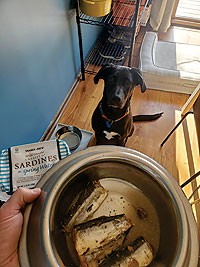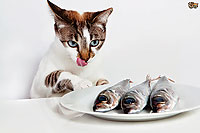Anchovies are considered one of the top marine-based sources of omega-3 fats, along with other fatty fish like wild salmon and sardines. EPA and DHA are the preferred forms of omega-3 fatty acids for pets, as they’re the most bioavailable. Studies have demonstrated the many health benefits of these omega-3s to animals, such as helping to:
Manage inflammation — EPA and DHA exert immunomodulatory and anti-inflammatory properties by inhibiting enzymatic pathways that lead to inflammation. They also act as precursors for resolvin, a potent anti-inflammatory compound that can resolve existing inflammation in your pet’s body.
Since inflammation is at the heart of many chronic diseases, reducing inflammation in your pet’s body can go a long way toward improving their health. In a study published in the journal In Vivo, after increasing EPA and DHA intake in cats and dogs, “therapeutic benefit was found in canine allergic dermatitis, haircoat disorder, keratoconjunctivitis sicca, valvular disease, and canine and feline osteoarthritis.”
Improve skin and coat health — In a 2020 study, 24 dogs with poor haircoat were given EPA and DHA for 90 days. The dogs’ hair and skin quality significantly improved, further supporting the potential benefits of using omega-3s to help manage inflammatory skin conditions like atopic dermatitis.
Support heart health — Aside from having anti-inflammatory properties, omega-3s also exhibit anti-arrhythmic effects, which may help lower the risk of arrhythmia that’s commonly implicated in heart failure. Omega-3 fats may also help improve the metabolism of energy in heart tissue, as well as endothelial function, heart rate, blood pressure and immune function.
Promote learning and development in puppies — Increasing DHA in weaned puppies helped improve their psychomotor skills, memory and cognition, and immunologic and retinal functions.
Protect brain health — A mice study published in the Journal of Neurotrauma found omega-3 fats may help protect brain health by reducing oxidative damage and increasing levels of brain-derived neurotrophic factor (BDNF), a protein that plays a key role in learning and memory.
Other Vitamins and Minerals in Anchovies
 Selenium is an essential trace element that plays important roles in thyroid metabolism, DNA synthesis, antioxidant systems, immune response and reproductive health. One of its most important actions is its ability to promote the production of glutathione, which is the “master antioxidant” in your pet’s body, as well as yours. Seafoods are listed as one of the best sources of this mineral, and that includes anchovies, which contain 36.5 micrograms of selenium per 100-gram serving. In addition to omega-3s and selenium, anchovies are a good source of niacin (vitamin B3), iron, calcium and zinc. These nutrients all contribute to your pet’s optimal health. Niacin is important for energy metabolism, digestion, skin health, DNA repair and nervous system function, while calcium is critical for animals’ growth and development, and for maintaining healthy bones and muscles. Zinc is an essential trace element, required for enzymatic, structural, and regulatory functions. In terms of iron, this mineral plays a role in red blood cell and hemoglobin production, energy metabolism, enzymatic functions and oxygen transport throughout the body. Selenium is an essential trace element that plays important roles in thyroid metabolism, DNA synthesis, antioxidant systems, immune response and reproductive health. One of its most important actions is its ability to promote the production of glutathione, which is the “master antioxidant” in your pet’s body, as well as yours. Seafoods are listed as one of the best sources of this mineral, and that includes anchovies, which contain 36.5 micrograms of selenium per 100-gram serving. In addition to omega-3s and selenium, anchovies are a good source of niacin (vitamin B3), iron, calcium and zinc. These nutrients all contribute to your pet’s optimal health. Niacin is important for energy metabolism, digestion, skin health, DNA repair and nervous system function, while calcium is critical for animals’ growth and development, and for maintaining healthy bones and muscles. Zinc is an essential trace element, required for enzymatic, structural, and regulatory functions. In terms of iron, this mineral plays a role in red blood cell and hemoglobin production, energy metabolism, enzymatic functions and oxygen transport throughout the body.
Is Toxin Contamination a Concern in Anchovies?
Anchovies have a short lifespan, so they do not live long enough to accumulate high amounts of toxins, making them a good choice if you want to supplement your pet’s diet with fish. According to a study published in Food and Chemical Toxicology, the traces of metals and mercury found in anchovies are well below all safety limits, so toxicity is unlikely to appear.
How to Choose and Serve Anchovies to Your Pets -
If you buy them fresh, you can serve them lightly cooked or offer them raw after freezing them at -4 degrees F (-15 degrees C) for seven days. If you can’t find fresh anchovies locally which is a frequent problem for most shoppers, try the freezer section of your supermarket. Most likely you will be able to buy canned anchovies, just make sure they’re packed in water. You may opt for anchovies packed in olive oil as well if your pet has no issues digesting healthy fats but it’s easy to overdo it with this option and cause some tummy upset. Many pet food specialties offer freeze dried or fish oils that come from anchovies and sardines. These offer many similar benefits to canned anchovies.
Avoid anchovies packed in salt, brine, soy or any other oils. Salt-cured anchovies are one of the most popular varieties sold in grocery stores but are NOT appropriate for pets, as the sodium content is too way too high. Always read labels carefully to make sure what you’re buying doesn’t contain ingredients that can potentially harm your pet. Uncured anchovies are the healthiest, but if you can only find canned anchovies, opt for anchovies packed in water or olive oil (not soybean oil).
Another important caveat about anchovies is that they’re high in iodine. While iodine-rich foods may benefit dogs that are prone to hypothyroidism, they can have the opposite effect on cats. Cats are prone to hyperthyroidism, so they need little iodine from their food — another reason why I don’t recommend feeding an exclusively fish-based diet to pets.
With that said, dogs and non-hyperthyroid cats can enjoy anchovies as an ingredient in their DIY treats or a meal topper on their nutritionally balanced homemade meal. When used as a treat, keep in mind that all healthy “extras” should make up less than 10% of your pet’s daily caloric intake. |